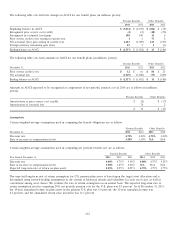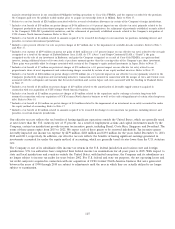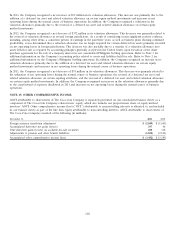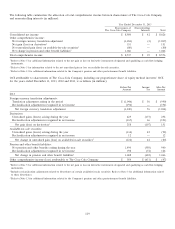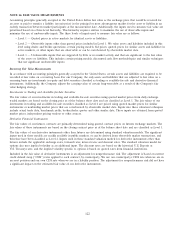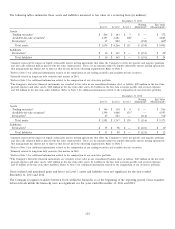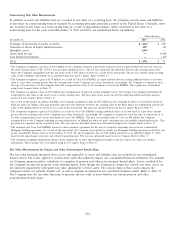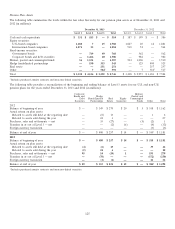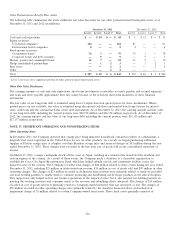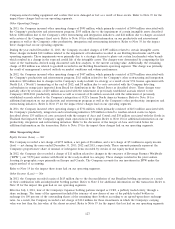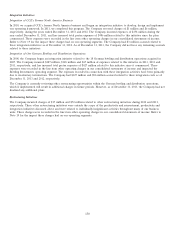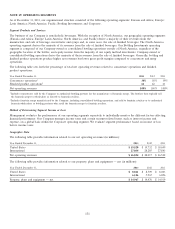Coca Cola 2013 Annual Report Download - page 124
Download and view the complete annual report
Please find page 124 of the 2013 Coca Cola annual report below. You can navigate through the pages in the report by either clicking on the pages listed below, or by using the keyword search tool below to find specific information within the annual report.NOTE 16: FAIR VALUE MEASUREMENTS
Accounting principles generally accepted in the United States define fair value as the exchange price that would be received for
an asset or paid to transfer a liability (an exit price) in the principal or most advantageous market for the asset or liability in an
orderly transaction between market participants at the measurement date. Additionally, the inputs used to measure fair value are
prioritized based on a three-level hierarchy. This hierarchy requires entities to maximize the use of observable inputs and
minimize the use of unobservable inputs. The three levels of inputs used to measure fair value are as follows:
• Level 1 — Quoted prices in active markets for identical assets or liabilities.
• Level 2 — Observable inputs other than quoted prices included in Level 1. We value assets and liabilities included in this
level using dealer and broker quotations, certain pricing models, bid prices, quoted prices for similar assets and liabilities in
active markets, or other inputs that are observable or can be corroborated by observable market data.
• Level 3 — Unobservable inputs that are supported by little or no market activity and that are significant to the fair value
of the assets or liabilities. This includes certain pricing models, discounted cash flow methodologies and similar techniques
that use significant unobservable inputs.
Recurring Fair Value Measurements
In accordance with accounting principles generally accepted in the United States, certain assets and liabilities are required to be
recorded at fair value on a recurring basis. For our Company, the only assets and liabilities that are adjusted to fair value on a
recurring basis are investments in equity and debt securities classified as trading or available-for-sale and derivative financial
instruments. Additionally, the Company adjusts the carrying value of certain long-term debt as a result of the Company’s fair
value hedging strategy.
Investments in Trading and Available-for-Sale Securities
The fair values of our investments in trading and available-for-sale securities using quoted market prices from daily exchange
traded markets are based on the closing price as of the balance sheet date and are classified as Level 1. The fair values of our
investments in trading and available-for-sale securities classified as Level 2 are priced using quoted market prices for similar
instruments or nonbinding market prices that are corroborated by observable market data. Inputs into these valuation techniques
include actual trade data, benchmark yields, broker/dealer quotes and other similar data. These inputs are obtained from quoted
market prices, independent pricing vendors or other sources.
Derivative Financial Instruments
The fair values of our futures contracts are primarily determined using quoted contract prices on futures exchange markets. The
fair values of these instruments are based on the closing contract price as of the balance sheet date and are classified as Level 1.
The fair values of our derivative instruments other than futures are determined using standard valuation models. The significant
inputs used in these models are readily available in public markets, or can be derived from observable market transactions, and
therefore have been classified as Level 2. Inputs used in these standard valuation models for derivative instruments other than
futures include the applicable exchange rates, forward rates, interest rates and discount rates. The standard valuation model for
options also uses implied volatility as an additional input. The discount rates are based on the historical U.S. Deposit or
U.S. Treasury rates, and the implied volatility specific to options is based on quoted rates from financial institutions.
Included in the fair value of derivative instruments is an adjustment for nonperformance risk. The adjustment is based on current
credit default swap (‘‘CDS’’) rates applied to each contract, by counterparty. We use our counterparty’s CDS rate when we are in
an asset position and our own CDS rate when we are in a liability position. The adjustment for nonperformance risk did not have
a significant impact on the estimated fair value of our derivative instruments.
122


